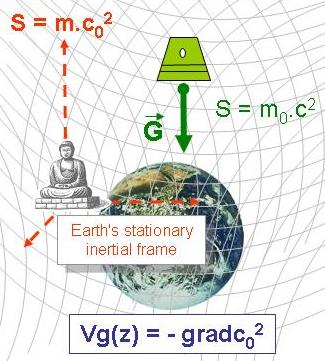Gravitation explained
Neither space-time curvature nor other weird concepts, the explanation is simple and obvious. Just take a few minutes to read it and many hours to meditate on it.
Gravitation acceleration yields no inertial force
It is a known fact of astronauts: when a space capsule free falls, its passengers float in weightlessness. This lack of force can be strangely regarded because the capsule is submitted to the constant acceleration of gravitation. Actually, any accelerated system at ground level yields an inertial force which is explained by synergetics in
a previous article.
Whereas official physics explains how an existing inertia is directly nullified by the weight, STEM-Physics, which primarily considers the interacting energies, relates this lack of force to a constant synergy.
Consequently the synergy of the capsule remains constant so that:
-
dS/dt = m0 .dc2 /dt = 0 (1)
Gravitation explained - Demonstration 1
The relationship (2) between the internal speed of light c and the external one c0 comes out from the expression of kinetic energy
already explained there. Unlike special relativity does, it is unnecessary to consider neither uniform motions nor constant speeds in order to obtain expression (2). It is therefore fairly applicable in the case of the capsule submitted to gravitation.
-
according γ = (1 - v2 /c0 2 )-1/2
-
c2 = γ.c0 2 (2)
-
so (1) and (2) imply: d(γ.c0 2 )/dt = 0 (3)
The external speed of light c0 can't be a constant because it would make expression (3) impossible to resolve. Thus (3) becomes:
-
c0 2 .dγ/dt + γ.dc0 2 /dt = 0 (4)
-
which infers (v.dv/dt + (2.c0 - 3.v2 /c0 ).dc0 /dt) = 0 (5)
In the obvious case where v << c0 , expression (5) provides the amazing formula in (6):
-
dv/dt = -1/v.dc0 2 /dt = -dc0 2 /dz (6)
The acceleration of the capsule, it is to say the acceleration of gravitation, equals the variation of the squared speed of light along space coordinates.
In conclusion, acceleration of gravitation occurs owing to the speed of light that decreases around masses.
-
Vg = - gradc0 2
Gravitation explained - Demonstration 2
A more straightforward demonstration is to consider the same object at two different heigths. Passing from the higher state to the lower corresponds to a loss of potential energy known as:
-
ΔEfield = m0 .Vg .Δh
Because free falling from the higher point to the lower yields no inertia, it can be deduced that synergy between the two states doesn't change:
-
ΔS = m0 .Δc0 2 + ΔEfield = 0
-
consequently m0 .Δc0 2 = - m0 .Vg .Δh
-
and Vg = - Δc0 2 /Δh
How much does the speed of light vary?
According the value of gravitation acceleration on earth (roughly 10 m/s2 ), and taking into account the difference of synergy between the ground and the top of the Eiffel Tower in Paris (roughly 300 m height), a difference of c0 2 is:
-
Δc0 2 = - 3,000 (m/s)2
-
also 2.c0 .Δc0 = - 3,000 (m/s)2
-
However, because of the huge value of the speed of light (3 10+8 m/s), a very few and non measurable difference of speed provides gravitation: Δc0 = - 0.5. 10-5 m/s along a 300 meters height
Amazingly, the gross of gravitation comes out from a tiny variation of the speed of light.

